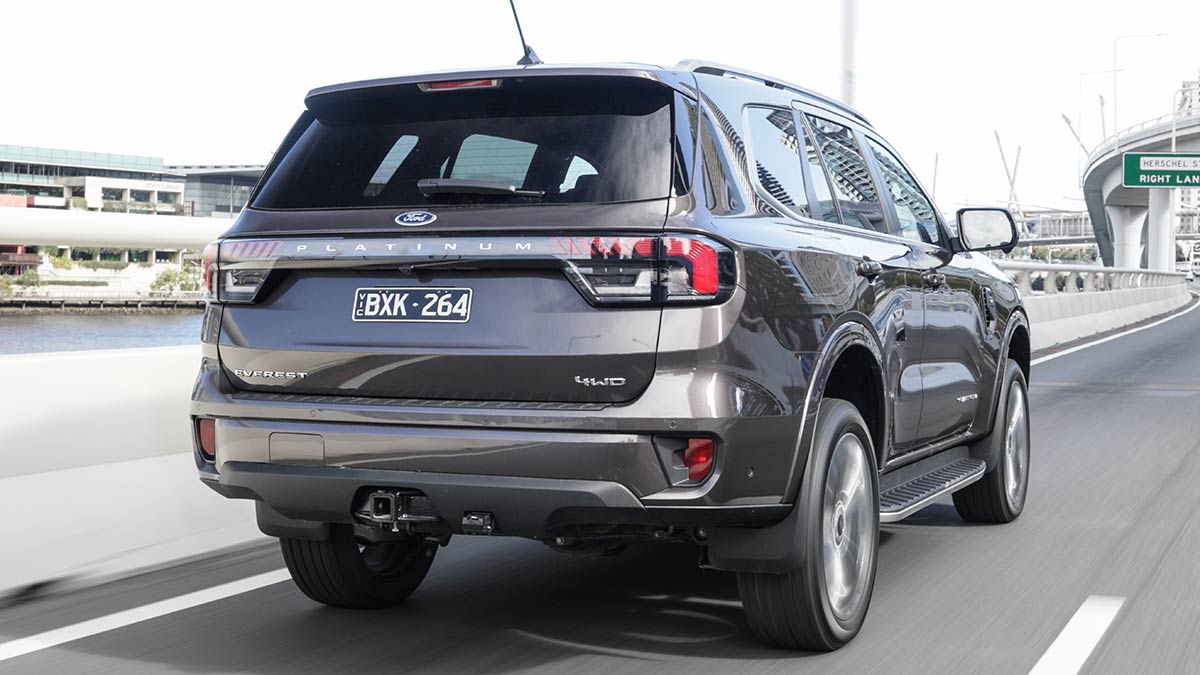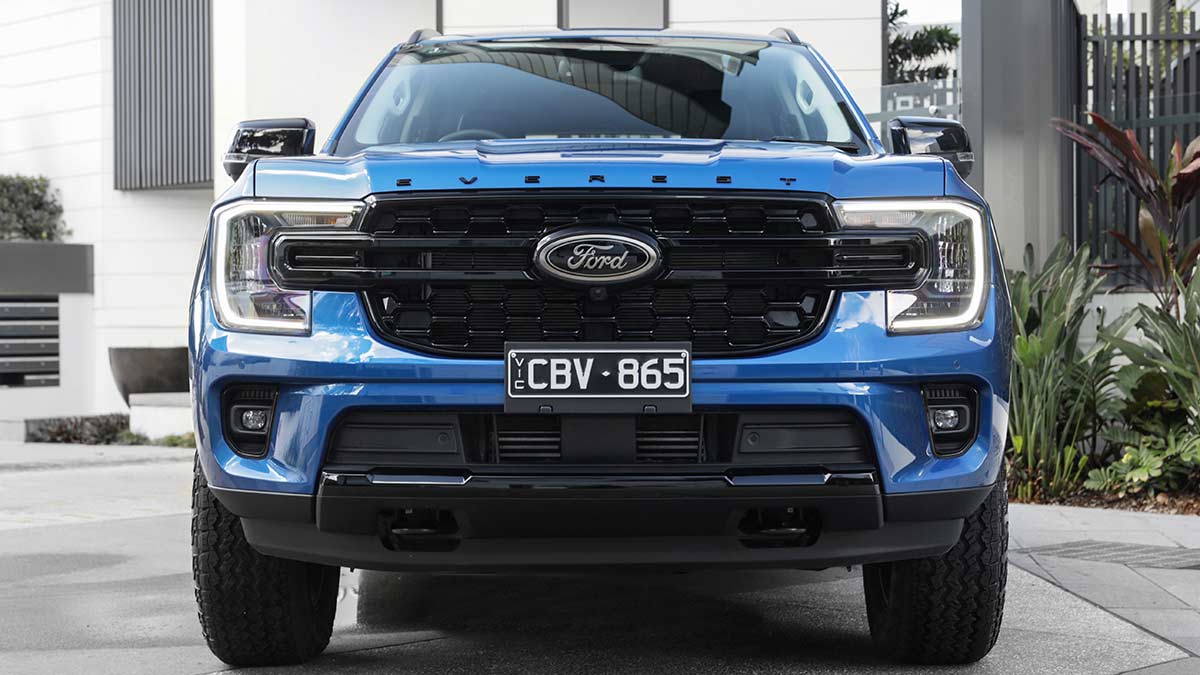The Xpeng G6 reads like a bona fide Tesla Model Y rival, but does that translate from the brochure to reality? Here we’re testing the more expensive G6 Long Range, which lives up to its name with a 570km claimed range.
Mountain to climb: 2022 Ford Everest first drive review

On paper, the new and improved Ford Everest has what it takes to conquer the Toyota Prado. Can it climb to the top of the seven-seat SUV charts?
Ford is chasing a tectonic shift in Australian car-buying habits with the launch of its new Ford Everest.
Based on the Ford Ranger but with family friendly coil-sprung rear suspension in place of the ute’s leaf springs, the Everest faces the formidable task of toppling the Toyota Prado, a vehicle has outsold the Blue Oval product by better than two to one since 2015.
The Everest’s edge is the fact this is a brand-new vehicle, while the Prado has been kicking around Australian cities and country tracks since late 2009.
Where the Everest holds an advantage, is in the drivetrain and ride enhancement. Traditional off-road buyers may still want lean to the Prado’s reputation for reliability, but they could well be swayed by the Ford’s refinement.
On this page
- How much does the Ford Everest cost?
- Is the Ford Everest safe?
- What's the Ford Everest like inside?
- What's under the Ford Everest's bonnet?
- Is the Ford Everest efficient?
- How does the Ford Everest drive?
- Should I buy one?
How much does the Ford Everest cost?
The starting price for a four-wheel-drive Ford Everest is $57,990 plus on-road costs for the fleet-oriented Ambiente. That turns into $63,613 on the road for Melburnians.
Move up to the Trend and the cost climbs to $65,290, or $71,224.
Both of the above models are sold with the 2.0-litre four-cylinder twin-turbo diesel engine, paired to a 10-speed automatic. Selecting rear-wheel-drive rather than 4WD trims the price by around $5,000.
The Sport and Platinum variants are powered by a 3.0-litre V6 twin-turbo diesel, using the same transmission.
The Sport has a sticker price of $69,090 or $75,183 on the road, with the Platinum topping out at $77,690 or $84,767.
Any colour other than white adds $675 to the bill.
The Ford Everest is covered by a five-year, unlimited kilometre warranty and the service intervals are set at 12 months/15,000km. The four-cylinder engine will cost $1,699 to service over the first five years, with the V6 set at $1,716 over the same period.
Obvious rivals include the Toyota Prado, which ranges in price from $60,830 to $86,998 plus on-roads and the Isuzu MU-X at a cost of $54,900-$67,400.
Is the Ford Everest safe?
ANCAP has awarded the Ford Everest with an impressive five-star safety rating.
Adult occupant protection was assessed at 86 per cent, child occupant protection was 93 per cent, vulnerable road user safety was deemed to be 73 per cent and safety assist features earned the big SUV an 86 per cent score.
Nine airbags are cached within the vehicle in case things do go wrong.
Default software-driven safety gear includes autonomous emergency braking, with reverse-brake assist, rear cross-traffic alert and post-impact braking (where the Everest automatically keeps the brakes on after the initial impact to avoid a secondary collision).
Then there’s lane-keep assist, a driver attention alert, front and rear parking sensors and blind-spot assist with trailer coverage (once the driver has input the tow vehicle’s length and width).
What’s the Ford Everest like inside?
The basic Ford Everest Trend makes do with a 10.1-iinch infotainment touchscreen. That’s not bad, but nowhere near as dramatic as the 12.0-inch display found in the higher-specified versions.
It also makes do with hard plastics on the upper door trims, a glovebox that lacks the slow-drop damping found in more expensive variants and a manually operated tailgate (yes, you have to pull it up and push it down). The default driver’s display is an 8.0-inch digital unit. Buyers also have to pay $950 to add the third-row seats.
The Trend adds rear tinted glass, powered driver’s seat, a leather steering wheel a secondary glove box (in lieu of an open shelf) and a powered tailgate.
Sport models include leather-accented front seats with powered, heated and ventilated functions and a 10-speaker sound system.
Finally, the Platinum includes quilted seats, with the outboard second row gaining heaters, heated steering wheel, a 12-speaker Bang & Olufsen sound system, 12.4-inch driver’s display and semi-automated parking, power-folding third-row seats, along with a 360-degree camera.
Boot space is 249 litres with all three rows in use. If you’re not using the third row, Ford has an innovative floorboard panel that can be raised to create in internal barrier to stop objects from sliding around. It involves lifting a panel and fitting braces, but is smart nonetheless.
What’s under the Ford Everest’s bonnet?
Ford Everest Ambiente and Trend are powered by Ford’s 2.0-litre four-cylinder twin-turbo diesel engine.
It is a proven mill, having seen service in the previous generation Ford Everest and Ranger.
Outputs of 154kW and 500Nm ensures it will deal with the Everest’s 3.5-tonne towing capacity. Note that the gross vehicle mass means payload (if you’re hauling maximum weight) is just 491kg for the Ambiente, given a kerb weight of 2259kg and a gross combined payload of 6250kg. That’s not a lot of bodies, when you subtract the 350kg of towball download mass from the payload figure.
Ford (as with most car manufacturers) quotes a payload of 741kg for the Ambiente, based on the gross tare mass of 2199kg.
At the other end of the spectrum, the Platinum will carry a (Ford claimed) 658kg based on tare mass, or 491kg on kerb mass.
Is the Ford Everest efficient?
The rated claimed combined fuel use for the Ford Everest Ambiente and Trend 4WD is 7.2 litres over 100km, rising to 8.3 litres/100km in the urban cycle, using that 2.0-litre diesel.
Move up to the V6-propelled Sport/Platinum and the figures are 8.5 litres/100km on the combined cycle and 10.2 litres/100km around town.
Those figures are pretty good for a vehicle well over two tonnes with this level of acceleration.
How does the Ford Everest drive?
Driving dynamics are part of the latest Ford Everest’s repertoire. It is heavier than the Ford Ranger, so the respective powertrains feel more muted compared to their ute brethren.
Unladen, there is also a touch of jostle in the cabin, though nowhere near as much head-tossing action as you’ll find in older large SUVs. Expect that motion to be more subdued with more weight in the cabin or on the towbar.
Tyre noise is heard in all variants, particularly the Platinum riding on 21-inch rims. It’s not going to interrupt your conversation, but it is there.
Selecting the various drive modes is as easy as twisting the dial mounted to the rear of the transmission lever, while the four-wheel-drive options are adjusted by pushing buttons mounted into the face of the same dial.
The drive position is benign, with enough adjustment in the seat (irrespective of the version and whether you are pushing buttons on physically adjusting things) to satisfy most owners.
The steering is relatively light, especially for a vehicle this size, and the brakes feel up to the job of stopping the Everest and whatever might be behind it.
Realistically, the Everest is a 5+2-seater, given if you force adults into the third row, everyone ahead of them will have to compromise leg room. Those down the back also miss out on USB ports (they do get a 12-volt socket), which is a faux-pas on this type of vehicle in 2022.
Should I buy one?
Don’t part with your Prado just yet. The road-biased drive programme didn’t showcase what the Ford Everest will be expected to do, so we’ll want to spend some time on gravel tracks at 80km/h and towing loads before it earns an endorsement.
Ford Everest Platinum buyers are already looking at delays well into 2023, so consider shopping for the Sport. Buyers still get the V6 engine, and you could argue that the blacked-out trim looks more appealing.
The information provided is general advice only. Before making any decisions please consider your own circumstances and the Product Disclosure Statement and Target Market Determinations. For copies, visit racv.com.au. As distributor, RACV Insurance Services Pty Ltd AFS Licence No. 230039 receives commission for each policy sold or renewed. Product(s) issued by Insurance Manufacturers of Australia ABN 93 004 208 084 AFS Licence No. 227678.












